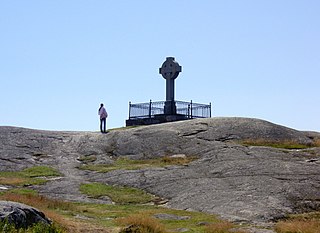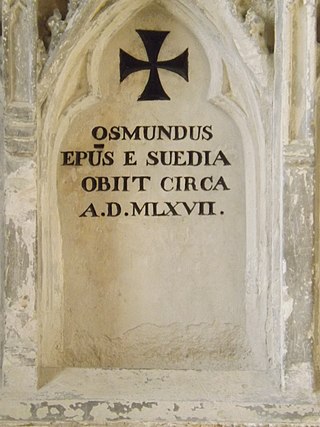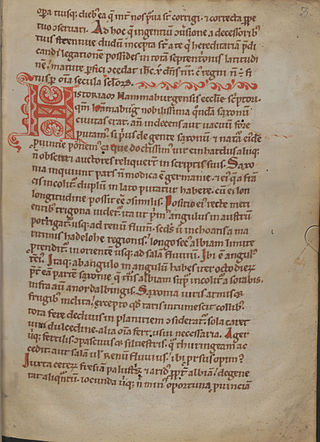Related Research Articles

Adam of Bremen was a German medieval chronicler. He lived and worked in the second half of the eleventh century. Adam is most famous for his chronicle Gesta Hammaburgensis ecclesiae pontificum. He was "one of the foremost historians and early ethnographers of the medieval period".

Birka, on the island of Björkö in present-day Sweden, was an important Viking Age trading center which handled goods from Scandinavia as well as many parts of the European continent and the Orient. Björkö is located in Lake Mälaren, 30 kilometers west of contemporary Stockholm, in the municipality of Ekerö.

Olof Skötkonung, sometimes stylized as Olaf the Swede, was King of Sweden, son of Eric the Victorious and, according to Icelandic sources, Sigrid the Haughty. He succeeded his father in c. 995. He stands at the threshold of recorded history, since he is the first Swedish ruler about whom there is substantial knowledge. He is regarded as the first king known to have ruled both the Swedes and the Geats. In Sweden, the reign of king Olov Skötkonung is considered to be the transition from the Viking age to the Middle Ages, because he was the first Christian king of the Swedes, who were the last to adopt Christianity in Scandinavia. He is associated with a growing influence of the church in what is today southwestern and central Sweden. Norse beliefs persisted in parts of Sweden until the 12th century.
Emund Eriksson, , was a Swedish king whose historicity is only known from a single source, the Gesta Hammaburgensis ecclesiae pontificum which was written by Adam of Bremen in c. 1075.
Erik Ringsson was a Swedish king and the son of Ring, according to the German ecclesiastic chronicler Adam of Bremen. He is said to have ruled together with his father and his brother Emund in about 936, and later presumably reigned in his own name.

The House of Munsö, also called the House of Björn Ironside, the House of Uppsala or simply the Old dynasty, is the earliest reliably attested royal dynasty of Sweden, ruling during the Viking Age. None of the names suggested for the dynasty are universally accepted and most are problematic; the name "House of Munsö" derives from a questionable and speculative theory that they would have ruled from the island of Munsö and the name "House of Björn Ironside" derives from the supposed founder of the dynasty, Björn Ironside, who is often seen as a legendary, rather than historical, figure.

Anund Jacob or James, Swedish: Anund Jakob was King of Sweden from 1022 until around 1050. He is believed to have been born on July 25, in either 1008 or 1010 as Jakob, the son of King Olof Skötkonung and Queen Estrid. Being the second Christian king of the Swedish realm, his long and partly turbulent reign saw the increasing dissemination of Christianity as well as repeated attempts to influence the balance of power in Scandinavia. Throughout his reign, he tried to subvert the rising Danish hegemony in Scandinavia by supporting the Norwegian monarchy. He also supported the reign of Yaroslav the Wise in Kievan Rus, his brother-in-law. He is referred to in positive terms in German and Norse historical sources. His reign was one of the longest in Sweden during the Viking Age and Middle Ages.
Emund the Old or Edmund was King of Sweden from c. 1050 to c. 1060. His short reign was characterised by disputes with the Archbishopric of Bremen over church policies, and a historically debated delimitation of the Swedish-Danish border.
Anund from Russia was the king of Sweden around 1070 according to Adam of Bremen's Gesta Hammaburgensis ecclesiae pontificum. According to this source, Anund came from Kievan Rus', presumably from Aldeigjuborg. Gårdske means that he came from Gardariki which was one of the Scandinavian names for Kievan Rus'.

The Archbishop of Uppsala has been the primate of Sweden in an unbroken succession since 1164, first during the Catholic era, and from the 1530s and onward under the Lutheran church.

Egino was the only bishop of Dalby in Scania, from 1060 to 1066. He was ordained by archbishop Adalbert of the Archbishopric of Bremen. The bishopric was separated from Roskilde in 1060, when the church in Denmark was reorganized in nine episcopal sees, but practically united with the see of Lund in 1066, after the death of bishop Henry of Lund. Thereby all of Terra Scania was subordinated to Hamburg-Bremen.

Naissaar is an island in Estonia. It is situated in the Gulf of Finland, northwest of the capital city Tallinn, and is administratively part of the Viimsi parish. The island covers an area of 18.6 square kilometres. It is 8 kilometres long and 3.5 kilometres wide, and lies about 8.5 kilometres from the mainland. The highest point on the island is Kunilamägi, which is 27 metres above sea level. The island consists predominantly of coniferous forest and piles of stones and boulders. In 2020, the island had a population of 17; in 2011 the island had 35 or so permanent residents and some summer residents. Administratively the island is divided into three villages: Lõunaküla (Storbyn), Tagaküla (Bakbyn), and Väikeheinamaa (Lillängin).

Saint Sigfrid of Sweden (Swedish: Sigfrid, Latin: Sigafridus, Old Norse: Sigurðr, Old English: Sigefrið/Sigeferð) was a missionary-bishop in Scandinavia during the first half of the 11th century. Originally from England, Saint Sigfrid is credited in late medieval king-lists and hagiography with performing the baptism of the first monarch of Sweden, Olof Skötkonung. He most likely arrived in Sweden soon after the year 1000 and conducted extensive missions in Götaland and Svealand. For some years after 1014, following his return to England, Sigfrid was based in Trondheim, Norway. However, his position there became untenable after the defeat of Olaf Haraldsson.

The sacred tree at Uppsala was a sacred tree located at the Temple at Uppsala, Sweden, in the second half of the 11th century. It is not known what species it was. Older sources have described it as an ash tree, but Frits Läffler have suggested that it was a yew tree.

Osmund or Asmund was a missionary bishop in Sweden in the mid-11th century.

Gesta Hammaburgensis ecclesiae pontificum is a historical treatise written between 1073 and 1076 by Adam of Bremen, who made additions (scholia) to the text until his death . It is one of the most important sources of the medieval history of Northern Europe, and the oldest textual source reporting the discovery of coastal North America.
Gunnhildr Sveinsdóttir or Gunnhildr Haraldsdóttir, Guda or Gyda was, according to the traditional view, a queen consort of King Anund Jacob of Sweden and of king Sveinn II of Denmark. However, the sources are so vague that several modern historians maintain that there were actually two queens of that name, of Sweden and Denmark respectively. She is sometimes called Gude or Gyridje, but this is probably because of confusion with her daughter, Gyda, who is also known under her mother's name Gunnhildr.

Kystpilgrimsleia, Norwegian for "Coastal Pilgrim Route", is the name of the pilgrim way that runs along the west coast of Norway and culminates at the Nidaros Cathedral in Trondheim. Kystpilgrimsleia is a joint project between four counties and four diocese to create a comprehensive and sustainable tourism product that promotes cultural heritage and provides a unique experience of more all the fjords of Norway.

Sigfred was a competitor for the Danish throne in 812. His brief appearance inaugurated a period of throne struggles in Denmark which lasted until 827.
References
- ↑ "Adamus: Gesta Hammaburgensis ecclesiae pontificum". Archived from the original on 2005-02-07. Retrieved 2005-02-07. Adam of Bremen, Gesta Hammaburgensis ecclesiae pontificum, online text in Latin. English translation of the selected sections is provided by the author of the article, since translations are not available in public domain. Discussion about translation is welcome.
- ↑ Probably Finnic tribes living in present-day northwestern Russia. Wizzi is usually regarded as Veps and Mirri as Merya.
- ↑ Naissaar — Nargen, Nargö, Terra Feminarum: Nature and nature conservation. Estonian Ministry of Environment, 1997.